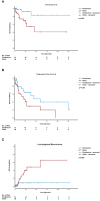Treatment with (chemo)-radiation in old patients (≥76 years of age) with newly diagnosed non-metastatic squamous cell cancer of the head and neck region: real-world data from a tertiary referral center
- PMID: 38725619
- PMCID: PMC11079188
- DOI: 10.3389/fonc.2024.1382405
Treatment with (chemo)-radiation in old patients (≥76 years of age) with newly diagnosed non-metastatic squamous cell cancer of the head and neck region: real-world data from a tertiary referral center
Abstract
Purpose: Treatment of patients with cancer of the head and neck region is in focus in a multitude of studies. Of these patients, one patient group, those aged 76 and more, is mostly underrepresented despite requiring thorough and well-reasoned treatment decisions to offer curative treatment. This study investigates real-world data on curative treatment of old (≥76 years) patients with newly diagnosed squamous cell carcinoma of the head and neck region (HNSCC).
Patients and methods: Between January 2010 and December 2021, we identified 71 patients older than 76 years with newly diagnosed HNSCC and cM0 at the Department of Radiation Oncology of the University Hospital of Erlangen-Nuremberg. Using electronic medical records, we analyzed treatment patterns and outcomes in terms of overall survival (OS), progression-free survival (PFS), and locoregional control (LRC) rate. Additionally, we performed univariate risk analysis and Cox regression in order to identify predictive factors associated with the abovementioned treatment outcomes.
Results: The median follow-up was 18 months. OS was 83%, 79%, and 72% after 1 year, 2 years, and 3 years, respectively. PFS was 69%, 54%, and 46% after 1 year, 2 years, and 3 years, respectively. A total of 34 (48%) patients were treated with standard therapy according to current guidelines. The reasons for deviation from standard therapy before or during treatment were as follows: unfitness for cisplatin-based chemotherapy (n = 37), reduction of chemotherapy (n = 3), and dose reduction/interruption of radiotherapy (n = 8). Carboplatin-based systemic therapy showed improved PFS compared to cisplatin or cetuximab (60 vs. 28 vs. 15 months, p = 0.037) but without impact on OS (83 vs. 52 vs. 38 months, p = 0.807). Oropharyngeal tumor localization (p = 0.026) and combined treatment (surgery and postoperative treatment) (p = 0.008) were significant predictors for a better OS. In multivariate analysis, oropharyngeal tumor localization (p = 0.011) and combined treatment (p = 0.041) showed significantly increased PFS. After 1 year, 2 years, and 3 years, the cumulative incidence of locoregional recurrences (LRRs) was 13%, 24%, and 27%, respectively, and was significantly decreased in patients with oropharyngeal tumor localization (p = 0.037).
Conclusions: Adherence to treatment protocols for radiotherapy alone in old patients with HNSCC is good, whereas the application of concurrent chemotherapy often deviates from guidelines in terms of de-escalation. An important risk factor for decreased OS, PFS, and a higher rate of LRR appears to be non-oropharyngeal tumor location in old patients.
Keywords: chemoradiation; head and neck cancer; old patients; squamous cell carcinoma; tumor localization.
Copyright © 2024 Winkler, Haderlein, Semrau, Putz, Höfler, Müller, Iro, Kesting, Fietkau and Schubert.
Conflict of interest statement
The authors declare that the research was conducted in the absence of any commercial or financial relationships that could be construed as a potential conflict of interest.
Figures


References
LinkOut - more resources
Full Text Sources

